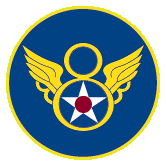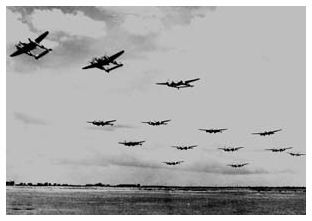

"A Little Known Fact Of World War II"
By: Maj. Jack Ilfrey

During the pre-dawn hours of February 25,1942,the City of Los Angeles distinguished itself by becoming the first, and only city in the continental United States to undergo a real enemy air attack - or what it thought was a real enemy air attack.
It was one of those tense nights of watchfulness that marked the early stages of WWII. Shortly before 2 am air defense radar picked up a mysterious blip approximately 100 miles off shore. By 2:07 am there was no longer any doubt: Unidentified aircraft, presumable hostile were inbound and closing fast.
Klaxons sounded. Troops rushed to their posts and in the great city sprawled across the coastal plain some two million people were awakened by the steady, terrifying wail of air raid sirens. Among those were the pilots and ground crews of the 94th. "Hat In The Ring" Ftr. Sq., 1st. Ftr. Gp. stationed at Long Beach Air[port, behind Signal Hill, flying our P-38's on patrol in defense of the west coast.

1st. Fighter Group P-38s
As a blackout was imposed upon metropolitan Los Angeles, traffic was halted and white-helmeted civil defense wardens took to the streets. Giant Army searchlights began probing the night sky for enemy bombers presumed to be marauding overhead.
Our ground crews ran to their assigned positions as we pilots suited-up and ran to our P-38s.
For hours the sky glowed with shell bursts as ack-ack gunners lofted thousands of rounds of high explosive ammunition. Amid the din, fear and rumor ran rampant. Pieces of schrapnel from the shells started falling in our area, hitting hangar and barracks roof,a few autos and a few aircraft.
We pilots prayed to the Good Lord above that we wouldn't be sent up in that barrage, enemy or not. Most everyone saw, or imagined something - Jap Zero's - P43's, Jap Betty Bombers. We were not sent up.
But by the time the sun rose and the smoke cleared, it was noted that nary an enemy bomb had actually fallen upon the balmy shores of Southern California. Thus the whole shooting match was soon dismissed as a grandiose false alarm.
While California politicians raged and the Navy chortled, the Army conceded jittery gunners might have been carried away by the sight of shadowy weather balloons, clouds or even U.S. interceptors from air bases close at hand.
After the war historians discovered that a Japanese submarine operating offshore at the time, the I-17, was unusally large in size and carried a collapsible catapult launched float plane. Some years later a newspaper reporter learned that the Army in 1942 had hushed up a key fact; existence of a coastal radar station at Santa Monica had confirmed an inbound blip that night.
So the mystery was renewed. A definitive answer could be supplied only by the officers and crewmen of Sub I-17, and along with their vessel and logbooks, they went down in the South Pacific in 1943.
Some of these facts are from my own recollections and others in the 94th. Sq. who were there. At our last reunion in Reno, Sgt. George "Sparky" Gemeiner remembered how he had run to his assigned battery cart on some landing lights. Upon returning to his barracks he found a timing element from a 40mm shell in his cot and a hole in the roof above.
The remaining facts were taken from an article by Eric Shuman that appeared in Feb-Mar, 1984 "Modern Maturity" and reprinted with permission from the editor, Alice Medina.
(Reprinted from King's Cliffe Remembered Vol.4 No.4)
__________________________________________________
RETURN TO BIOGRAPHY
RETURN TO 1st.FG
